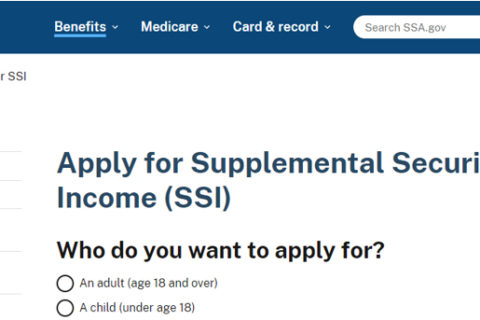Stopping work due to a disability is a heartbreaking thing that every worker never thinks about. Some are even forced to retire early because they have medical conditions that prevent them from working at a young age for a long time—at least 12 months—or are expected to end in death.

If this also happens to you, don’t mourn this sad thing. However, Social Security’s Disability Insurance (SSDI) program can assign you a disability benefit, as long as you qualify for it. Sure, there are a few things that make you eligible to receive SSDI benefits.
That said, calculating the amount of SSDI benefits can be complicated because the formula can change every year. Then, how much money will you get? And how is it calculated in 2024?
What is Social Security’s Disability Insurance (SSDI)?
Social Security’s Disability Insurance (SSDI), or in short, “Disability,” is one of the federal social programs that is provided to people who have worked for a minimum of 5 years but are forced to stop since they experience permanent disability.
This program is administered by the Social Security Administration (SSA), so people who are entitled to receive SSDI benefits are people who have paid social security taxes. Your insurance payment obligations will terminate after you stop working.
There is no doubt that SSDI really helps improve financial support for SSDI beneficiaries and specific family members because SSA provides monthly case payments. For SSDI, the maximum family benefit is approximately 85% to 150% of the disabled worker’s benefit.
Beneficiaries will receive SSDI benefits in the 6th month after your alleged onset date, and they will pay back SSDI benefits due at least 12 months before the application date.
Requirements to Obtain SSDI Benefits
Before determining how much you should receive from your monthly SSDI benefits, the Social Security Administration (SSA) will first assess whether you qualify for them.
There are a few requirements that you should meet to obtain SSDI benefits, including:
-
- Work a minimum of five years out of ten years.
- Pay taxes to Social Security.
- Have a serious medical condition that prevents you from doing work?
SSDI benefits are only intended for individuals who are completely disabled.
Here’s a list of medical sections that meet SSDI’s medical condition standard:
-
- Musculoskeletal Disorders
- Special Senses and Speech
- Respiratory Disorders
- Cardiovascular System
- Digestive Disorders
- Genitourinary Disorders
- Hematological Disorders
- Skin Disorders
- Endocrine Disorders
- Congenital disorders that affect multiple body systems
- Neurological Disorders
- Mental Disorders
- Cancer (Malignant Neoplastic Diseases)
- Immune system disorders
Reportedly, in 2021, the musculoskeletal system and connective tissue accounted for the largest number of SSDI diagnoses, approximately 34%, for SSDI recipients’ medical conditions.
To qualify for SSDI, you definitely need to prove that you meet the disability rules before your disability insurance ends. And SSA will calculate the time frame for each individual based on their specific employment history.
Determining the SSDI beneficiaries can be complicated, as it will be based on the following two things:
-
- Have you worked long enough to qualify for insurance?
- When does your disability insurance end?
Of course, you won’t qualify for the SSDI benefits if you’ve not worked a full five years or if you have not paid the social insurance into the SSA’s system.
How is the SSDI Benefit Calculated Per Month?
The SSA will use a certain formula that is based on the amount you pay into their system to calculate how much you may receive in your monthly SSDI benefits. On average, SSDI payments range between $1,300 and $1,600 per month.
First, SSA will use your Average Indexed Monthly Earnings (AIME) as the starting point to calculate your monthly SSDI payment. AIME is your average income that you obtain from jobs covered by Social Security, which is adjusted for inflation.
Second, the formula will be applied to your AIME to calculate your primary insurance amount (PIA), which is the amount of monthly SSDI benefits that SSA will give to you. To calculate this, the SSA will use a progressive formula, like tax brackets.
But if income is above a certain threshold, it will be counted as less than income below the threshold. It’s important to note that the threshold changes every year.
Here’s the 2024 formula to calculate the SSDI payments:
| 90% of your first $1,174 of AIME 32% of your AIME between $1,175 an $7,078, and 15% of any AIME above $7,078. |
Assuming your AIME is $4,000. And 90% of the first $1,174, which is $1,056, and 32% of the remaining $2,826, which is $904. So, it can be calculated as $1,056 + $904, so the total benefit is $1,960.
So, you will receive $1,960 every month if this is your case.
For your information, the average monthly benefit that SSDI beneficiaries received was $1,352.32 as of October 2023. And in 2024, the maximum monthly SSDI payment will be $3,822 per month.
However, only a few people receive maximum results, and the national average is approximately $1,537 per month.
To note:
The SSA will not determine the amount of monthly SSDI you will receive based on how long you have been disabled and unable to work and how severe your disability is.
Instead, they will provide you with monthly SSDI based on your lifetime income paid in Social Security taxes. Also, depending on the length of your employment history, they may not use your entire previous income to determine your AIME.
Luckily, SSA will use your highest earning years if they only select a portion of your earnings history, so your average SSDI amount will go up, not down.
How to Check Your Primary Insurance Amount
You can definitely check your PIA to estimate your monthly benefits. Of course, there are a few options you can take to do so, such as:
-
- Using SSA’s online benefit calculator
- Create your account at ssa.gov/myaccount/
- Contact your local SSA office
- Call the National SSA 1800 number at 1-800-772-1213
Why is Your SSDI Benefit Reduced?
The amount of SSDI payment is based on your work history before you experienced your disability, including a monthly payment and Medicare.
If you’re eligible to receive SSDI benefits, you may have to report changes to your personal information, income, and work.
Situationally, the SSA may reduce your monthly SSDI benefit amount for the following reasons:
-
- Your employment income
- Workers’ Compensation
- SSA retirement benefits
- Other insurance benefits
- Government debt that is still in collectible status
How to Apply for SSDI Benefits
Everyone who qualifies for SSDI benefits can apply for it, either:
-
- Option 1: Via the SSA official website (https://secure.ssa.gov/iClaim/dib)
- Option 2: By phone, call SSA representatives at 800-772-1213
- Option 3: Apply at your local SSA office. To find the nearest one, you can check here: https://secure.ssa.gov/ICON/msg012View.action.
Once you submit your SSDI application, SSA will review it along with your work history and medical records. They may send your case to a disability examiner at your state’s Disability Determination Service (DDS).
It may take 6–9 months for them to review your SSDI application. For further stages, they may ask to schedule an evaluation or send you other forms.
To check the status of your application, you can log into your SSA account. In addition, you can also find an estimate of how long your request will take. After they have completely reviewed it, they will send you a mail informing you whether or not your application is approved.
Conclusion
SSDI benefits are provided to people aged 18–64 who have worked for a long time in a qualifying job and have a permanent disability that prevents them from working, either in their previous job or in a new job.
SSA will use their own formula to calculate how much of the SSDI benefits you’ll get, and it’s based on your Average Indexed Monthly Earnings (AIME) and the current threshold.

A bookworm and researcher especially related to law and citizenship education. I spend time every day in front of the internet and the campus library.




